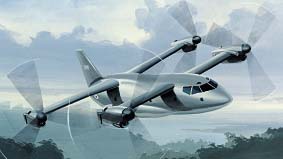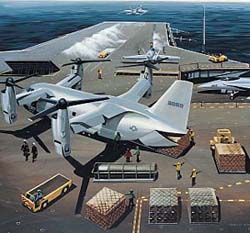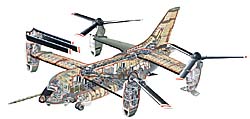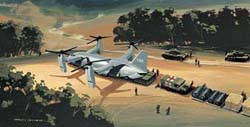V-44
The Pentagon�s next transport flies like a plane, lands like a helicopterand unloads enough firepower to start-or stop-a war.
 Some planes are so beautiful they could hang in art museums even if they couldn't fly. Others--the Wart Hog tank-killer comes to mind--are as homely as their names. And then there is the Pentagon's next wonder-plane, the V-44. It's ugly, coyote ugly, with wings. Four wings to be exact. Each is tipped with a tilting nacelle that converts the V-44 from a helicopter that can land or take off wherever a truck can make a U-turn to a 300-mph fixed-wing transport, troop carrier or gunship. Still on the drawing board, the plane we've informally designated the V-44 derives from the V-22 Osprey, a two-wing tiltrotor that is now undergoing final evaluations by the Marine Corps. The need for a quad-rotor version stems from what defense analysts predict will be fundamental changes in the nature of war in the 21st century. Desert Storm was your father's war. Tomorrow, low-intensity conflicts will be the rule as the anointed battle the infidels, plant police take on drug barons, and taxmen shoot it out with money launderers.
Some planes are so beautiful they could hang in art museums even if they couldn't fly. Others--the Wart Hog tank-killer comes to mind--are as homely as their names. And then there is the Pentagon's next wonder-plane, the V-44. It's ugly, coyote ugly, with wings. Four wings to be exact. Each is tipped with a tilting nacelle that converts the V-44 from a helicopter that can land or take off wherever a truck can make a U-turn to a 300-mph fixed-wing transport, troop carrier or gunship. Still on the drawing board, the plane we've informally designated the V-44 derives from the V-22 Osprey, a two-wing tiltrotor that is now undergoing final evaluations by the Marine Corps. The need for a quad-rotor version stems from what defense analysts predict will be fundamental changes in the nature of war in the 21st century. Desert Storm was your father's war. Tomorrow, low-intensity conflicts will be the rule as the anointed battle the infidels, plant police take on drug barons, and taxmen shoot it out with money launderers.
Uncle Sam has decided to step into the fray as the policeman of this new world disorder. His billy club will be a new military deployment strategy that puts ready-to-fight brigades on the ground in 96 hours. American armed forces will get into the action on a new type of plane, the V-44 Future Transport Rotorcraft (FTR).

A quad tiltrotor could be put into production as early as 2010.
Twice A V-22
The FTR will provide a capability that does not exist anywhere in the world today--and perhaps will replace the helicopter for military operations. The concept for the aerial assault platform comes from Bell Helicopter Textron. Having teamed with Boeing on the twin-engine V-22 Osprey tiltrotor program, Bell has developed the concept for a larger fuselage. Envisioned to be about the size of a stretched C-130 Hercules, the FTR would feature two V-22-type wings, each having an engine and a combination rotor-propeller mounted at the outboard tips. The exact configuration has yet to be determined. Some versions show a tailless aircraft, others have an airframe more along the lines of a C-130.
There is no disagreement about the interior. The V-44 is designed to be a heavy hauler. "Imagine this aircraft with a cabin large enough to internally carry an 8 x 8 x 40-ft. container, several helicopters, all types of high mobility multipurpose wheeled vehicles, light armored vehicles, eight standard loading pallets, or 70 [medivac] litters," reads an industry analysis describing the concept. "Imagine an aircraft that could transport 80 to 100 troops or 10 to 20 tons of equipment and supplies at speeds greater than 300 mph over distances from 1000 to 2000 miles and then safely land vertically, without the need for runways or airports."
 The FTR concept can be traced back as far as the early 1960s when the Curtiss-Wright Corp. built the X-19, a small quad-rotor testbed. After 50 successful test flights, it was destroyed in an accident. A second X-19 was scrapped. Enthusiasm for the FTR, however, is based on the technical success of the V-22 Osprey. These aircraft can be configured to carry 24 combat troops or up to 20,000 pounds of internal or external cargo at twice the speed of a helicopter. U.S. procurement plans call for 360 Marine Corps MV-22 aircraft and 50 U.S. Air Force CV-22 aircraft. Using parts common with the Marine MV-22, the Air Force CV-22 modification includes the addition of internal-wing fuel tanks and terrain-avoidance and terrain-following radars. It also has been given an enhanced electronic warfare suite, additional cockpit seating for a flight engineer, an aerial refueling probe and an internally mounted rescue hoist.
The FTR concept can be traced back as far as the early 1960s when the Curtiss-Wright Corp. built the X-19, a small quad-rotor testbed. After 50 successful test flights, it was destroyed in an accident. A second X-19 was scrapped. Enthusiasm for the FTR, however, is based on the technical success of the V-22 Osprey. These aircraft can be configured to carry 24 combat troops or up to 20,000 pounds of internal or external cargo at twice the speed of a helicopter. U.S. procurement plans call for 360 Marine Corps MV-22 aircraft and 50 U.S. Air Force CV-22 aircraft. Using parts common with the Marine MV-22, the Air Force CV-22 modification includes the addition of internal-wing fuel tanks and terrain-avoidance and terrain-following radars. It also has been given an enhanced electronic warfare suite, additional cockpit seating for a flight engineer, an aerial refueling probe and an internally mounted rescue hoist.
The FTR will use a pair of V-22 propulsion systems. Each is based on two Rolls-Royce Allison AE 1107C 6150-shp engines and a computer-controlled rotor coordination system that permits a safe landing if one engine loses power.
 An obvious question is whether the four rotors could operate in such close proximity without creating turbulence that would shake apart the aircraft or make it impossible to control. To answer this question, Bell draws on data reaching back to its X-22 ducted propeller quad tiltrotor, which flew 500 flights between 1966 and 1988. The results encouraged Bell to test a pair of V-22s at a distance approximating the spacing between the fore and aft wings of a V-44. According to Dick Spivey, Bell's director of advanced concepts, the test was a success. Water tunnel tests showed that the rotor wakes from the front engines flowed down and inboard--below and inboard of the rear rotors. Technically, there is no reason this bird shouldn't fly.
An obvious question is whether the four rotors could operate in such close proximity without creating turbulence that would shake apart the aircraft or make it impossible to control. To answer this question, Bell draws on data reaching back to its X-22 ducted propeller quad tiltrotor, which flew 500 flights between 1966 and 1988. The results encouraged Bell to test a pair of V-22s at a distance approximating the spacing between the fore and aft wings of a V-44. According to Dick Spivey, Bell's director of advanced concepts, the test was a success. Water tunnel tests showed that the rotor wakes from the front engines flowed down and inboard--below and inboard of the rear rotors. Technically, there is no reason this bird shouldn't fly.
Thus configured, it could carry twice the payload and eight times the internal volume of cargo transported by the V-22. A true multiservice aircraft, it would reportedly meet the expanded needs of the Marine Corps' Ship-To-Objective Maneuver operations, support Air Force Aerospace Expeditionary Force units and meet many Army requirements for a future Joint Transport Rotorcraft (JTR). In the Army's case, officials envision a JTR that will replace some of the aging CH-47 Chinook helicopters. The Navy has its eye on the quad tiltrotor to make deliveries to its oceangoing fleet, much as the C-2A Greyhound now services carriers.
Early requirements issued by the Defense Department call for the ability to transport 8 to 12 tons of cargo over 600 miles with return at cruise speeds of 300 knots. Bell Helicopter engineers believe that their FTR concept would come very close to meeting these criteria.
A Formidable Gunship
 Troop buildups would no longer require runways.
Troop buildups would no longer require runways.
In addition to the FTR's cargo-hauling abilities, the possibility of putting tiltrotor technology into combat can be seen in another industry analysis. With advanced laser weapons and precision fire control, the craft could provide protection for overtaking a captured or damaged airport or seaport, making such sites accessible to allied forces.
Gunship applications are just one of several ideas being explored. A joint panel is looking at all of the rotorcraft possibilities. "They're looking at joint common lift replacement aircraft, to include a medium assault, a utility and an attack and anti-armor aircraft," explains Marine Corps Capt. Aisha Bakkar-Poe. "The Marine Corps' view is that tiltrotor is the way of the future because it has such a longer range and goes so much faster that it almost makes a helicopter obsolete."
 Some planes are so beautiful they could hang in art museums even if they couldn't fly. Others--the Wart Hog tank-killer comes to mind--are as homely as their names. And then there is the Pentagon's next wonder-plane, the V-44. It's ugly, coyote ugly, with wings. Four wings to be exact. Each is tipped with a tilting nacelle that converts the V-44 from a helicopter that can land or take off wherever a truck can make a U-turn to a 300-mph fixed-wing transport, troop carrier or gunship. Still on the drawing board, the plane we've informally designated the V-44 derives from the V-22 Osprey, a two-wing tiltrotor that is now undergoing final evaluations by the Marine Corps. The need for a quad-rotor version stems from what defense analysts predict will be fundamental changes in the nature of war in the 21st century. Desert Storm was your father's war. Tomorrow, low-intensity conflicts will be the rule as the anointed battle the infidels, plant police take on drug barons, and taxmen shoot it out with money launderers.
Some planes are so beautiful they could hang in art museums even if they couldn't fly. Others--the Wart Hog tank-killer comes to mind--are as homely as their names. And then there is the Pentagon's next wonder-plane, the V-44. It's ugly, coyote ugly, with wings. Four wings to be exact. Each is tipped with a tilting nacelle that converts the V-44 from a helicopter that can land or take off wherever a truck can make a U-turn to a 300-mph fixed-wing transport, troop carrier or gunship. Still on the drawing board, the plane we've informally designated the V-44 derives from the V-22 Osprey, a two-wing tiltrotor that is now undergoing final evaluations by the Marine Corps. The need for a quad-rotor version stems from what defense analysts predict will be fundamental changes in the nature of war in the 21st century. Desert Storm was your father's war. Tomorrow, low-intensity conflicts will be the rule as the anointed battle the infidels, plant police take on drug barons, and taxmen shoot it out with money launderers.
 The FTR concept can be traced back as far as the early 1960s when the Curtiss-Wright Corp. built the X-19, a small quad-rotor testbed. After 50 successful test flights, it was destroyed in an accident. A second X-19 was scrapped. Enthusiasm for the FTR, however, is based on the technical success of the V-22 Osprey. These aircraft can be configured to carry 24 combat troops or up to 20,000 pounds of internal or external cargo at twice the speed of a helicopter. U.S. procurement plans call for 360 Marine Corps MV-22 aircraft and 50 U.S. Air Force CV-22 aircraft. Using parts common with the Marine MV-22, the Air Force CV-22 modification includes the addition of internal-wing fuel tanks and terrain-avoidance and terrain-following radars. It also has been given an enhanced electronic warfare suite, additional cockpit seating for a flight engineer, an aerial refueling probe and an internally mounted rescue hoist.
The FTR concept can be traced back as far as the early 1960s when the Curtiss-Wright Corp. built the X-19, a small quad-rotor testbed. After 50 successful test flights, it was destroyed in an accident. A second X-19 was scrapped. Enthusiasm for the FTR, however, is based on the technical success of the V-22 Osprey. These aircraft can be configured to carry 24 combat troops or up to 20,000 pounds of internal or external cargo at twice the speed of a helicopter. U.S. procurement plans call for 360 Marine Corps MV-22 aircraft and 50 U.S. Air Force CV-22 aircraft. Using parts common with the Marine MV-22, the Air Force CV-22 modification includes the addition of internal-wing fuel tanks and terrain-avoidance and terrain-following radars. It also has been given an enhanced electronic warfare suite, additional cockpit seating for a flight engineer, an aerial refueling probe and an internally mounted rescue hoist. An obvious question is whether the four rotors could operate in such close proximity without creating turbulence that would shake apart the aircraft or make it impossible to control. To answer this question, Bell draws on data reaching back to its X-22 ducted propeller quad tiltrotor, which flew 500 flights between 1966 and 1988. The results encouraged Bell to test a pair of V-22s at a distance approximating the spacing between the fore and aft wings of a V-44. According to Dick Spivey, Bell's director of advanced concepts, the test was a success. Water tunnel tests showed that the rotor wakes from the front engines flowed down and inboard--below and inboard of the rear rotors. Technically, there is no reason this bird shouldn't fly.
An obvious question is whether the four rotors could operate in such close proximity without creating turbulence that would shake apart the aircraft or make it impossible to control. To answer this question, Bell draws on data reaching back to its X-22 ducted propeller quad tiltrotor, which flew 500 flights between 1966 and 1988. The results encouraged Bell to test a pair of V-22s at a distance approximating the spacing between the fore and aft wings of a V-44. According to Dick Spivey, Bell's director of advanced concepts, the test was a success. Water tunnel tests showed that the rotor wakes from the front engines flowed down and inboard--below and inboard of the rear rotors. Technically, there is no reason this bird shouldn't fly. Troop buildups would no longer require runways.
Troop buildups would no longer require runways.